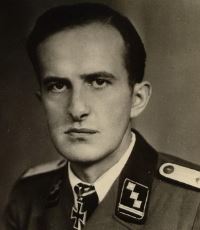Hasse, Frank (Waffen SS)
- Date of birth:
- October 19th, 1917 (Hohenwiese, Hirschberg, Germany)
- Date of death:
- December 24th, 1944 (Petit Coo, Stavelot, Belgium)
- Buried on:
- German War Cemetery Lommel
Grave: UNK. - Service number:
- SS-Nr.: 365.507 // NSDAP-Nr.:
- Nationality:
- German (1933-1945, Third Reich)
Biography
Promotions:
01.11.1939: SS-Sturmmann
20.05.1940: SS-Rottenführer
30.01.1942: SS-Untersturmführer
21.06.1943: SS-Obersturmführer
Career:
15.10.1937: joined the SS
00.02.1939: SS-Anwärter, 3./ LSSAH
00.03.1941: SS-Rottf. 3./ LSSAH
00.09.1941: SS-SOJ., 6. Kriegs-Junker-Lehrgang, Junker-Schule Braunschweig
00.02.1943: SS-Ustuf., Krad.Z, III./ SS-Pz.Gren.Rgt.1, LSSAH
00.10.1943: SS-Ostuf., Chef, 13./ SS-Pz.Gren.Rgt.1, LSSAH
00.12.1944: SS-Ostuf. Chef, 11./ SS-Pz.Gren.Rgt.1, LSSAH
24.12.1944: murdered by Belgian partisans
Do you have more information about this person? Inform us!
- Period:
- Second World War (1939-1945)
- Period:
- Second World War (1939-1945)
- Period:
- Second World War (1939-1945)
- Awarded on:
- October 1st, 1940
- Period:
- Second World War (1939-1945)
- Awarded on:
- October 1st, 1940
- Period:
- Second World War (1939-1945)
- Awarded on:
- May 1st, 1943
- Period:
- Second World War (1939-1945)
- Awarded on:
- August 20th, 1943
- Period:
- Second World War (1939-1945)
- Awarded on:
- June 15th, 1944
- Period:
- Second World War (1939-1945)
- Rank:
- SS-Obersturmführer (Lieutenant)
- Unit:
- Chef, 13. Kompanie, SS-Panzer-Grenadier-Regiment 1, LSSAH
- Awarded on:
- July 21st, 1944
- Period:
- Second World War (1939-1945)
- Rank:
- SS-Obersturmführer (Lieutenant)
- Unit:
- Chef, 11. Kompanie, SS-Panzer-Grenadier-Regiment 1, LSSAH
- Awarded on:
- August 6th, 1944
“On the 10.07.1944 the SS-Panzergrenadier-Regiment 1 ‘LSSAH’, positioned in the sector Louvigny—Eterville (just to the southwest of Caen), came under attack by enemy forces coming from the north. III. Bataillon, to which SS-Obersturmführer Hasse (commander of the 11. Kompanie) belonged to, was located in the depth of the defense along the northern edge of Maltot (south of Eterville). After an hours-long preparatory barrage of unprecedented ferocity against the villages of Eterville and Maltot, which saw a great part of our forces in this position become casualties, the enemy succeeded in pushing past the village of Eterville and entering Maltot.
SS-Obersturmführer Hasse and his Kompanie (which was being set aside as a reserve) received the order to restore contact with the left wing of the III. Bataillon, deploy facing towards the west and cover the open left wing of the Bataillon. At the same time the tank-supported enemy forces managed to push those elements of the III. Bataillon located in Maltot even further towards the east. By now the foremost hostile elements had already reached the command post of the III. Bataillon, located in a Chateau 800 metres southeast of Maltot. There now existed an extreme danger that the enemy would continue their thrust past Maltot towards the southeast and cross over the Orne river.
Recognizing this impending disaster, Hasse acted against his orders and on his own initiative. Initially with just a single Zug from his Kompanie available to him, he moved against the enemy forces in Maltot from the east. In bitter close combat, which saw Hasse fight alongside the lead units of his Kompanie, he succeeded in battle against the overwhelming enemy infantry and tank forces due to his extraordinarily brave personal example. Inspired by their commander, the handful of men present managed to gain ground westwards into the village. Hasse and his men, by now reinforced with another Zug and an HMG squad from the Kompanie, were able to repeatedly fend off the tank-supported enemy counterthrusts in bitter and intense combat. In the process 4 enemy tanks were knocked out in close combat. Although Hasse and his Kompanie had to endure almost continuous bombardment from enemy artillery fire, they were repeatedly inspired into attack by the tireless encouragement of SS-Obersturmführer Hasse.
When an additional Kompanie supported by a Tiger could be spared to enter the scene at 18:00, the 11. Kompanie had already retaken two-thirds of the village. From then on until the total reconquest of Maltot SS-Obersturmführer Hasse was the soul of the attack.
It is exclusively to the personal credit of SS-Obersturmführer Hasse that the enemy did not succeed in fully capturing the village of Maltot, which in turn averted the danger of an enemy crossing of the Orne. Hasse’s success is even more noteworthy when one considers that he was leading a Kompanie that had only been assembled as a unit a few weeks prior, and consisted of only a few veteran soldiers.
The enemy lost the following during the fighting for Maltot at the hands of Hasse’s Kompanie and the reinforcements that later arrived…
- 4 tanks
- 5 armoured tractors
- 2 APCs
- 168 rifles
- 51 light machine-guns
- 15 mortars
- 71 SMGs
- 5 anti-tank rifles
- 4 anti-tank guns
- 1 radio set
- At least 200 dead and 210 prisoners
On account of his brave actions I thereby propose that SS-Obersturmführer Hasse be awarded with the Knight’s Cross to the Iron Cross. SS-Obersturmführer Hasse is in every way worthy of the recommended award.”
Sources
- Photo 1:
- - Ritterkreuz Vorschlag supporting sketch.
- Die Ordensträger der Deutschen Wehrmacht
- Scheibert H., Die Träger des Deutschen Kreuzes in Gold (Kriegsmarine, Luftwaffe, Waffen-SS) und Deutschen Kreuzes in Silber (Heer, Kriegsmarine, Luftwaffe, Waffen-SS)
- Microfilm Publication A3343. US National Archives.












